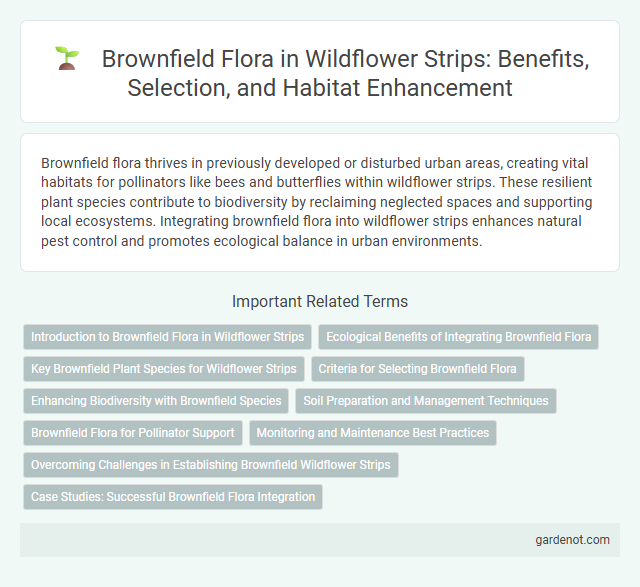Brownfield flora thrives in previously developed or disturbed urban areas, creating vital habitats for pollinators like bees and butterflies within wildflower strips. These resilient plant species contribute to biodiversity by reclaiming neglected spaces and supporting local ecosystems. Integrating brownfield flora into wildflower strips enhances natural pest control and promotes ecological balance in urban environments.
Introduction to Brownfield Flora in Wildflower Strips
Brownfield flora in wildflower strips consists of resilient plant species adapted to disturbed, often contaminated urban or industrial sites, contributing to biodiversity and ecosystem restoration. These plants tolerate poor soil conditions and thrive in nutrient-poor substrates, supporting pollinators and other wildlife. Incorporating brownfield flora in wildflower strips enhances habitat connectivity and promotes urban ecological resilience.
Ecological Benefits of Integrating Brownfield Flora
Integrating brownfield flora into wildflower strips enhances biodiversity by providing essential habitats for pollinators and rare plant species often adapted to disturbed soils. These resilient native plants improve soil health through natural remediation processes, promoting nutrient cycling and reducing erosion. Incorporation of brownfield flora supports ecosystem stability and resilience, contributing to the restoration of urban and degraded landscapes.
Key Brownfield Plant Species for Wildflower Strips
Key brownfield plant species for wildflower strips include Red Bartsia (Odontites vernus), Common Knapweed (Centaurea nigra), and Field Scabious (Knautia arvensis), all renowned for their resilience in disturbed soils. These species contribute significantly to biodiversity by supporting pollinators such as bees and butterflies, enhancing ecological value in urban or post-industrial areas. Integrating these hardy brownfield flora into wildflower strips promotes natural regeneration and secures vital habitats within fragmented landscapes.
Criteria for Selecting Brownfield Flora
Selecting brownfield flora requires prioritizing native, drought-tolerant perennial species that thrive in nutrient-poor, disturbed soils typical of brownfield sites. Emphasis on ecological resilience and biodiversity support ensures restoration of local habitats while preventing invasive species proliferation. Soil contamination tolerance and adaptability to variable microclimates are critical criteria for successful wildflower strip establishment on brownfield land.
Enhancing Biodiversity with Brownfield Species
Brownfield flora plays a vital role in enhancing biodiversity within wildflower strips by introducing resilient, site-adapted species that thrive in disturbed soils. Incorporating native brownfield species such as ragwort and knapweed supports pollinators and creates habitats for specialist insects and birds. This strategic planting boosts ecological stability and promotes a diverse ecosystem in degraded urban and semi-urban environments.
Soil Preparation and Management Techniques
Effective soil preparation for brownfield flora involves initial soil testing to assess pH levels, nutrient content, and contamination presence, ensuring optimal conditions for wildflower seed germination. Techniques such as soil aeration, organic matter incorporation, and careful removal of invasive species promote healthy microbial activity and improve soil structure. Regular soil monitoring and targeted amendments maintain fertility, supporting the thriving growth of native wildflowers in brownfield strip restoration.
Brownfield Flora for Pollinator Support
Brownfield flora plays a crucial role in supporting pollinators by providing diverse nectar and pollen sources in otherwise neglected urban areas. These native wildflowers and hardy plants adapt well to disturbed soils, offering essential habitats and food resources for bees, butterflies, and other pollinators. Promoting brownfield flora in wildflower strips enhances biodiversity and strengthens ecological resilience in urban environments.
Monitoring and Maintenance Best Practices
Effective monitoring of Brownfield flora in wildflower strips involves regular vegetation surveys to track species diversity and health, utilizing GPS mapping for precise data collection. Maintenance best practices include periodic removal of invasive species, controlled mowing schedules tailored to plant phenology, and soil health assessments to support native flora resilience. Implementing adaptive management strategies based on monitoring results ensures the long-term sustainability and ecological value of Brownfield wildflower habitats.
Overcoming Challenges in Establishing Brownfield Wildflower Strips
Establishing wildflower strips on brownfield sites requires addressing soil contamination and nutrient imbalances to support native flora growth. Techniques such as soil remediation, selection of tolerant plant species, and careful site preparation improve the survival rates of wildflowers. Incorporating diverse seed mixes tailored to brownfield conditions enhances biodiversity and ecosystem resilience.
Case Studies: Successful Brownfield Flora Integration
Brownfield sites transformed with wildflower strips demonstrate remarkable biodiversity recovery, as evidenced by case studies in urban areas like Manchester and Detroit, where native wildflower species regenerated crucial pollinator habitats. Research reveals that integrating tailored wildflower mixes adapted to soil contaminants enhances floral resilience and supports rare Brownfield flora, boosting ecosystem services such as pollination and soil stabilization. Long-term monitoring of these restored Brownfield sites confirms increased insect populations and improved ecological connectivity, fostering sustainable urban green spaces.
Brownfield flora Infographic

 gardenot.com
gardenot.com